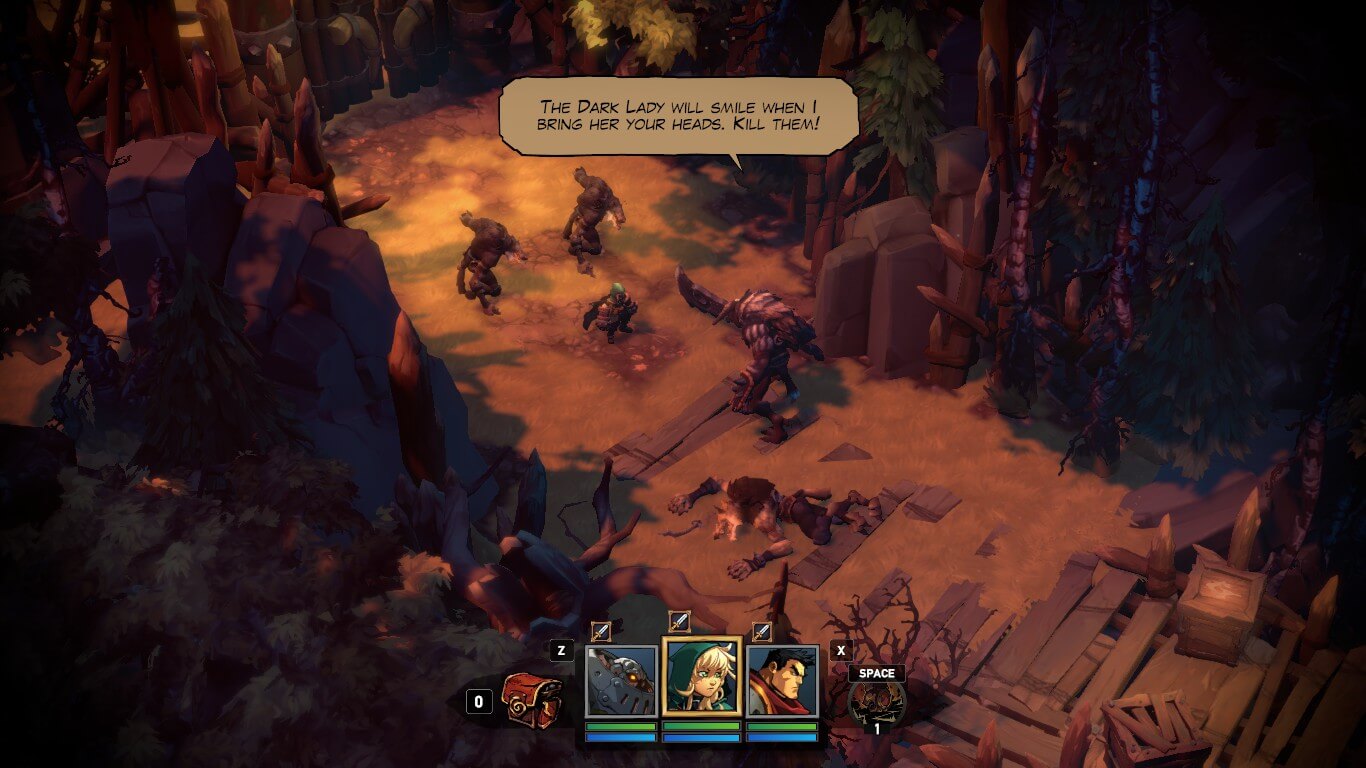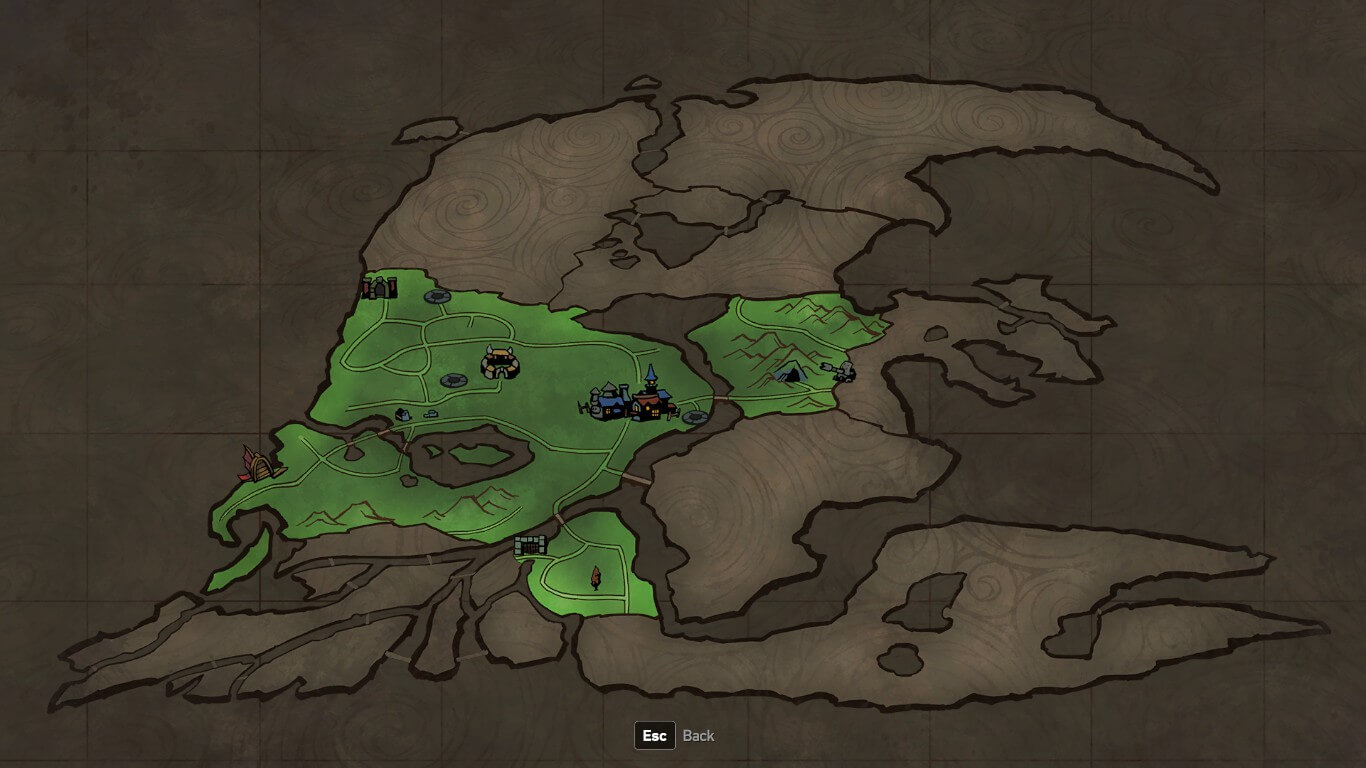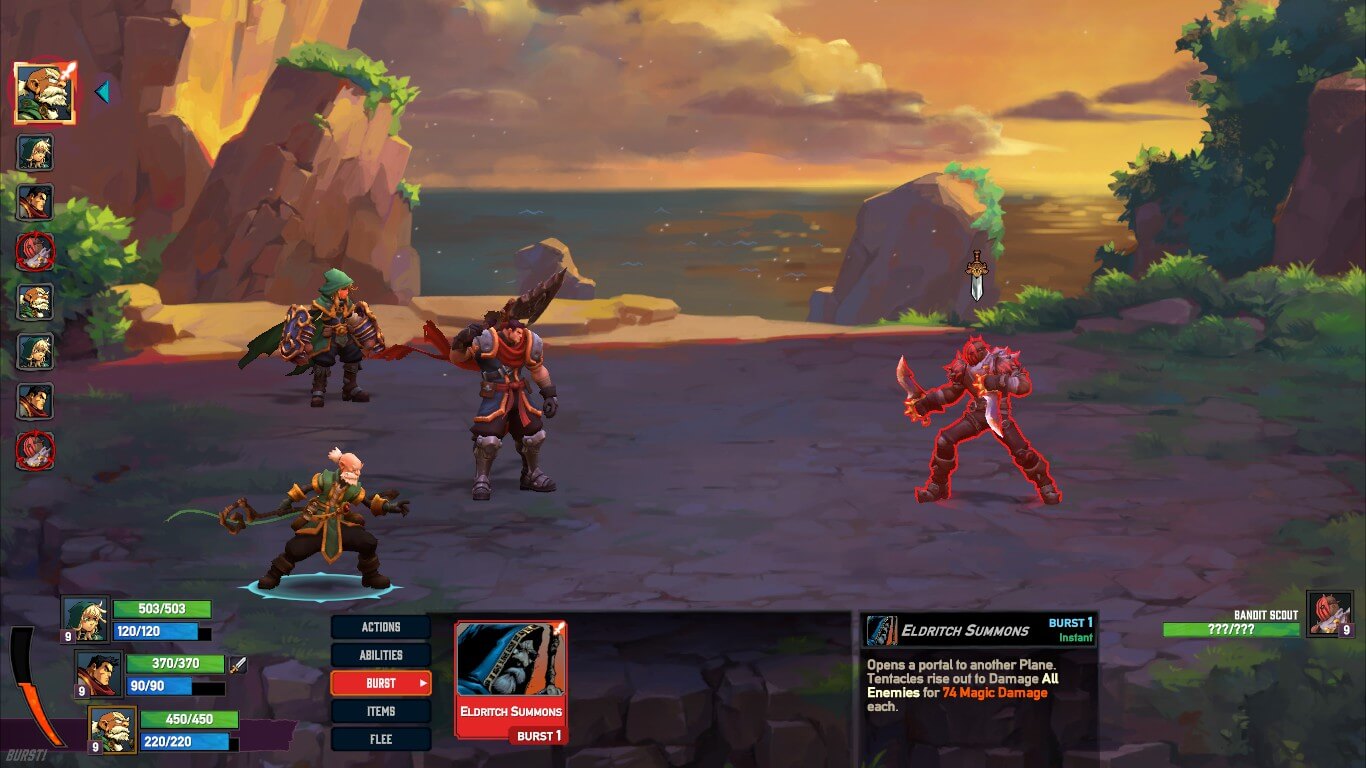A popular series of comic books in the nineties, Battle Chasers suffered from a severe case of cliffhanger ending, a fate which was preempted by four years of slow updates. Following a successful Kickstarter campaign, however, fans and newcomers alike have been treated to an animated roleplaying game that picks up from where the original story petered out. We’ve taken a look at its recent Steam release.
After a brief recap of the five main characters’ stories, Nightwar kicks into action with a fully voiced, animated-panel style cutscene that sees your party split up after a brief and unexpected fall through the sky. Not only does this set the scene, but it sets the quality for the art to come. Animated scenes like this are few throughout the game (and the voice acting disappears for the most part in favour of text) but they underline important moments in the story with narrative vibrant in its illustration.
The rest of the time, characters are portrayed in 3D, immersed in a beautifully crafted landscape which makes up for some of the rough framerates it experiences at lower system specifications. When you eventually land in combat, each move has its own animation — there’s a smooth flow to them that negates any repetition you might normally feel from seeing the same move over and over again. That said, burst attack animations (more on them later) are far longer and grow old quick.

The world you travel across is a smattering of points of interest connected by roads which your characters cannot stray from, made remarkably difficult to navigate with any foresight due to the sheer unhelpfulness of the map. A few little drawings are no substitute for a key, labels, area names or even a large ‘you are here’ arrow jabbing itself angrily at the particular spot of road your party occupies at that point in time.
It’s frustrating, that’s for sure.
But that’s okay, because there are no random encounters to add to the frustration. Enemies and loot spawn in predetermined locations along the roads, replenishing their numbers every time you complete a dungeon or rest in an inn. Since they’re displayed as an icon of themselves, you can recognise enemies you’ve fought before and pick a path that encounters the ones you’d prefer — or you could just wipe out all the enemies in that area of the map.

One of the first places you come across is the unironically named Harm’s Way, a small village with a separate map view which will serve as a hub for your future adventures on the islands. You can shop, craft and receive sidequests by talking to characters here, along with sleeping in the inn to restore your party. Every other location is a dungeon or explorable area that you can actually walk around in. These are shown, as in the picture above, in a colourful 3D view just as appealing as the rest of the art in the game.
Do the dungeons live up to the art that brings them to life? Well, sort of. You travel through a series of rooms with perambulating enemies just waiting to spot and attack you, initiating combat when you do. There are lore entries and little tidbits of information scattered around and, of course, there are traps. Traps that deal damage before they hit you (looking at you, falling spikes). Traps that you’re doomed to traverse again if you decide to save and quit. Why? Because reloading won’t load you where you left off — you’ll have to go through the entire dungeon again. The first bunch of enemies may be gone, but if you’ve already taken a lot of damage, the traps could do you in.
Your characters have some skills to help you out here, with in-dungeon abilities ranging from healing to blasting fire at enemies. It’s a sad fact that the offensive skills don’t work nearly as well as they should. The system feels slow and the timings marginally off — maybe three quarters of our skills failed to have the desired effect. There are a few puzzles in these location, though, making a pleasant change from other activities. Generally speaking, Nightwar has done a great job of keeping its locations, and each room within them, diverse and interesting. It’s just a shame it has some mechanical let-downs.

Fishing is a minigame you can take part in in explorable locations as well, but the point of it soon dwindles to insignificance. With no instruction on what to do with your catch, fishing becomes more a matter of collection than anything else, but even that begins to fail as the fishing spots outlevel your equipment faster than you can upgrade them. The sole trader who accepts your fish apparently resides in one location, but we failed to find them. It’s a part of Nightwar that feels rather out-of-place compared to everything else. The crafting system is a similarly under-explained mechanic, but somewhat simple to pick up. Its major let down is that you don’t have access to every crafting station in the town until very high levels. This is perhaps a tactic to force you to re-visit dungeons, but the drudgery of navigating there and finding the station tends to put one off.
On the surface, with little other quest-related direction, it would seem as if you only have to visit a dungeon once, with higher difficulty levels an option to use in dungeons if you fancy coming back later. Each main quest takes place in a different area, as is appropriate, and sidequests tend to do the same, except for those received at the inn. While defeating more enemies gives various party-wide bonuses, it may have been nice to see some other objectives thrown in to soften the blow of the inevitable grind.
The main story is the driving force behind Nightwar and its cutscenes are the most rewarding points of the game, as you grit your teeth against tricky bosses to reach them. And while at the beginning the tale itself may goad you onward, that motivation dries out with the motivation of the characters. It goes without saying that the party has to reassemble at some point — the manner of their doing so saps the drive from the story and what has turned out to be its already plodding momentum. Exciting it may be when it starts, but it grows stale around the ten hour mark, when if anything the pace should be picking up.

Outside the art, combat is one thing Nightwar does rather well, although there are still a few setbacks. Combat feels smooth and flows from one action to another, but characters’ initiative doesn’t always seem to work the way you’d think and it would have been a good idea to show a little more information about an enemy during combat once you’ve unlocked it. In any case, it’s fairly standard for a JRPG — actions are instant, but often weaker than abilities, which cost mana to cast. Each member of your six member team has unique skills that mean everyone has something to bring to the party.
Bursts are particularly fun to begin with — activated when the burst meter gets to a certain level, they tend to do a large amount of damage or healing and you can unlock more powerful ones as you level. Some characters’ bursts seem more useful than others’, however. The burst bar is filled with each turn in battle, mercifully carrying over between fights. Also unlocked upon level-up are perk points, which can be allocated to passive skills to customise your characters’ build. It’s a useful tool implemented well, providing just enough choice without being confusing.
In the beginning, combat feels ‘just right’, with a decent amount of challenge in some fights and a satisfying experience overall. You rarely have to use items, which is good, because such things are rare or expensive. You can keep up with the amount of healing you have to do, but still have to rest in the inn periodically. All is well with the world.

But then you approach the ten hour mark. Boy-oh-boy, does that jump in difficulty ever sneak up on you. One second you’re having to think a bit about your fights, the next you’re throwing yourself against brick-wall monoliths that wipe two of your party before you can move. You’re encountering enemies you previously found easy and being trampled into the dirt. Items you hoarded — even the special ones you bought with boss loot — are consumed in the course of one fight only to have your party wiped and all those materials lost.
You try a new approach. You take on a sidequest appropriate to your level. You die.
Again and again it happens until, fed up, you realise the implications of your discovery. You have to grind. This might be acceptable if the curve was gradual. It might be benign if we had a chance to chip away at the problem before being thrown in at the deep end. But Nightwar’s curveball is an unexpected, highly annoying hurdle to slam into before you try to jump it, hard to justify for its abruptness.
Nightwar is a game of quality, but the enjoyment that brings turns to frustration as the journey continues. While there may be more than ten hours of content out there, unless you’re happy to grind the same locations again and again, or forewarned enough to start the grind early, it may not be worth it. A disappointing judgement for a title whose first moments promised so much more.